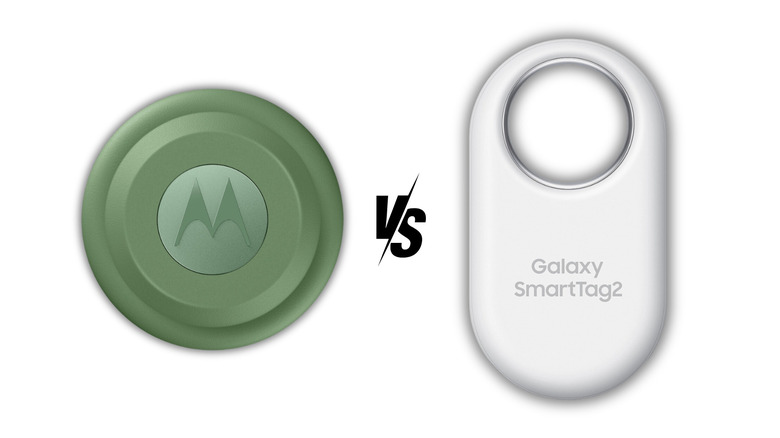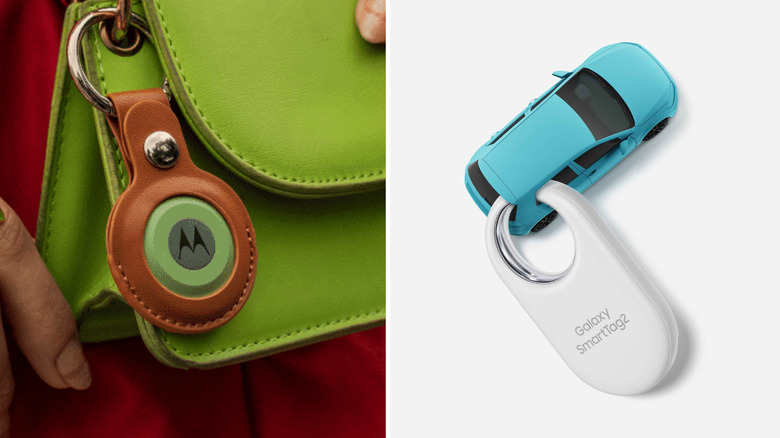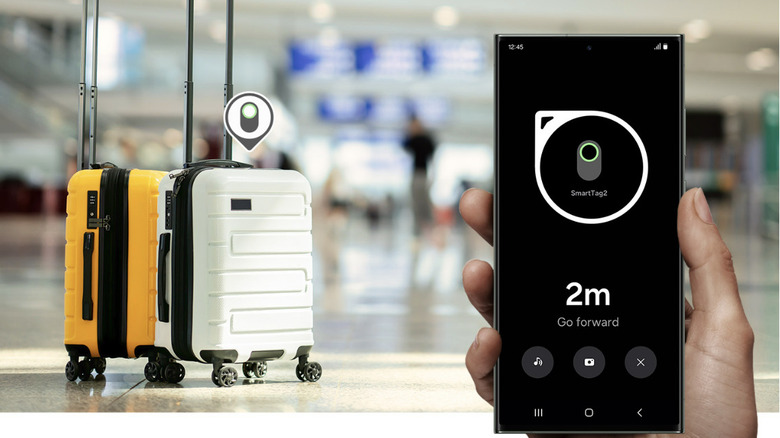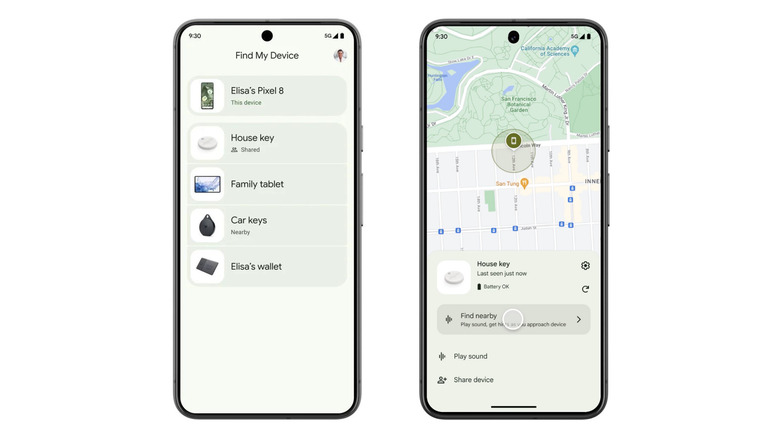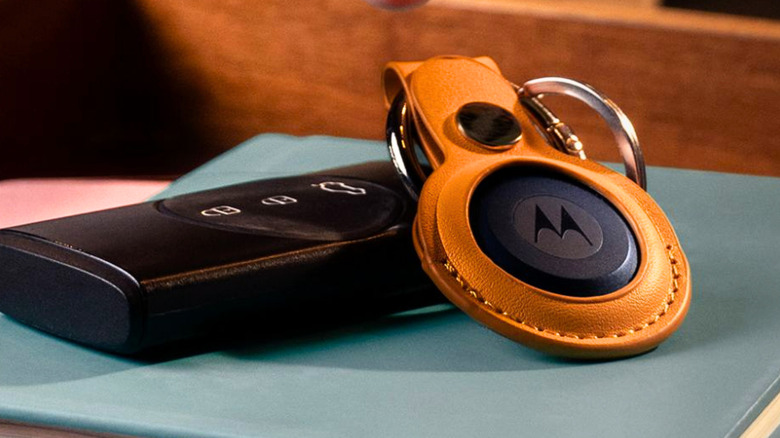Moto Tag Vs. Samsung SmartTag2: Which Is Better For Android Users?
We may receive a commission on purchases made from links.
The Lenovo-owned consumer tech brand Motorola has launched its first Bluetooth tracker. Dubbed Moto Tag, the device taps into Google's Find My Device network to track a tagged object. Further, it also features ultra-wideband (UWB) technology that helps in precise location tracking (similar to Apple's Precision Finding feature). For a first-generation product, the Moto Tag is equipped with all the must-have features, but how does it compare with the Samsung SmartTag2, one of its biggest rivals for Android phones?
Bluetooth trackers have been around for quite some time, helping users find their items within seconds. While companies like Tile and Chipolo have been at it for much longer, it was Apple that shook the portable trackers industry in April 2021 with the UWB-equipped AirTags. Soon, other manufacturers like Samsung and Tile followed suit.
While the inclusion of UWB on AirTags sure motivated other brands to improve their Bluetooth trackers, it has also led to confusion among Android users. In 2024, a Samsung or a Moto user can choose from roughly a dozen options, with devices from Tile and Samsung topping the list of best trackers. However, with Motorola's foray into the segment, the dynamics are going to change a bit, especially since the Moto Tag competes directly with the Samsung SmartTag2. Although both trackers are built exclusively for Android devices, there are some key differences that can help buyers choose one over the other.
Moto Tag Vs. Samsung SmartTag2: Design
Let's start by comparing how Motorola and Samsung have designed their Bluetooth trackers. To kick things off, the Moto Tag ships with a coin-shaped exterior and a plastic body that is IP67-rated for dust and water resistance. It comes in two colors: Starlight Blue and Jade Green. The device measures 31.9 x 8 millimeters and weighs 7.5 grams. Interestingly, Moto Tag's dimensions are identical to those of the AirTags, so you should be able to fit it in a third-party AirTag case. It is worth mentioning that the Moto Tag doesn't come with a lanyard loop. It also has a multi-functional button that can be used to ping the connected phone or as a remote shutter.
On the other hand, the Samsung SmartTag2 has a slightly bigger form factor, measuring 28.8 x 52.44 x 8.0 millimeters. Unlike the Moto Tag, Samsung's pill-shaped tracker has a cutout for attaching keychains (lined with a metallic ring). Even so, the company makes multicolor silicone cases for the device, which itself comes in black and white. Weighing 13.75 grams, the SmartTag2 is a tad heavier, but that is not to say that the weight will cause any inconvenience of any sort. For quick actions like ringing your phone or turning on a connected smart light, the SmartTag2 also has a multi-functional button. The tracker, like Moto Tag, features an IP67 rating (fit for submersion up to one meter for 30 minutes).
Both trackers offer precision tracking and crowdsourced location
Jumping onto the UWB bandwagon, the Moto Tag features precise location tracking, just like the Samsung SmartTag2. However, the fine print on Motorola's website suggests that UWB-based precision tracking in the Find My Device app will be available via an update in the near future. Samsung's SmartThings Find app, on the other hand, already supports the feature, wherein it utilizes augmented reality to show directions to the tagged item. It is important to mention that both trackers would require UWB-supported smartphones, such as the Moto Edge 50 Ultra or the Galaxy S24 Ultra, for the feature to work.
While Moto hasn't specified the range of its Bluetooth tracker per se, the official product page mentions that the device runs on Bluetooth v5.4 and supports the Bluetooth Low Energy range. This range, as a standard, is around 100 meters depending on the surroundings and obstructions between the phone and the tracker. Samsung SmartTag2, however, features Bluetooth v5.3 and has a maximum tracking range of 120 meters.
Connecting the Moto Tag with a compatible Android phone shouldn't take long, as the device supports Google's Fast Pair technology. Similarly, the SmartTag2 connects seamlessly with a Galaxy phone.
Google's Find My Device vs. Samsung's SmartThings
Even though both devices feature UWB-based precise location tracking and a decent Bluetooth range, one key difference isn't immediately apparent: the supported operating systems. The Moto Tag is compatible with Google's Find My Device network, which means that virtually every device running Android 9 or above, including Samsung phones, can use the tracker. Unfortunately, this isn't true for the SmartTag2, which only works with the SmartThings app on Galaxy phones. While this is good news for Samsung users — as they can choose between the two trackers — those who own a smartphone from another brand, such as Motorola, OnePlus, or Google, for that matter, have to go with the Moto Tag.
Even though both networks users to check a device's current location, play a sound on the device, and support user data encryption, Google seems to be a bit behind. While the network doesn't support UWB-based tracking for showing directions to the tagged item, it rolled out with a default setting that only allows users to locate their devices in high-traffic areas. Yes, the company is encouraging users to change the tracking setting to "With network in all areas," but it still has to improve the network's efficiency and efficacy. On the brighter side, Google's network can detect third-party unknown trackers (even AirTags), while the SmartThings app can only detect SmartTags.
Battery life and additional features
Like Apple's AirTag, both the Moto Tag and the Samsung SmartTag2 pack a replaceable CR2023 battery that hardly costs a couple of bucks. But there's a stark difference in how long the two devices can last before you need to pop in a new cell. The Moto Tag can last up to a year (365 days), while the SmartTag 2 is rated to survive up to 500 days, and that's just in the Normal Mode. Samsung's Bluetooth tracker features a Power Saving Mode to extend its battery life up to 700 days. Even so, the actual battery life depends on several factors, including how often you use the tracking devices, the signal strength, etc.
For now, the Moto Tag is priced at $29 per unit, while a pack of four trackers costs $99. Similarly, the SmartTag2 costs $29.99 per unit, and the pack of four costs $99.99. When it comes to accessories, like a Silicone Case or a Rugged Case, you certainly have more first-party options with the SmartTag2. Even though both the trackers provide similar features, the SmartTag2, despite its incompatibility with the Find My Device network, provides more functionality from the get-go (with a better battery life). On the other hand, the Moto Tag promises to be the AirTag that Google never had, but it might take some time to get there.
